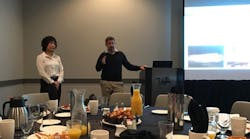Major changes in the recently published 2016 version of ANSI/ASHRAE/IES 90.1, Energy Standard for Buildings Except Low-Rise Residential Buildings, was the subject of the 2017 ASHRAE Press Breakfast, held this morning at the Las Vegas Convention Center as part of the 2017 International Air-Conditioning, Heating, Refrigerating Exposition (AHR Expo).
Bing Liu, a former member of the 90.1 committee who is group manager responsible for Pacific Northwest National Laboratory’s (PNNL's) Building Energy Regulatory Analysis Group and a program manager overseeing the Building Energy Codes Program in support of the U.S. Department of Energy, provided an overview of the changes:
- 121 addenda.
- Major format changes for each use.
- New climate maps aligning with ANSI/ASHRAE Standard 169-2013, Climatic Data for Building Design Standards.
- A new performance-based compliance path.
- Significant whole-building energy changes.
Michael Rosenberg, a member of the 90.1 committee and the chief senior research scientist for PNNL, detailed major changes related to:
- Envelope—fenestration, walls and doors, building air leakage.
- Mechanical—increased equipment-efficiency requirements, replacement equipment needing to meet many requirements formerly for new equipment only, automatic reduction of HVAC when hotel/motel guestrooms are unoccupied, chilled-water-plant metering, economizer fault detection and diagnostics.
- Lighting—reduced lighting-power allowances for exterior, interior, and retail display lighting; the requirement that exterior and parking-garage lighting be reduced by 50 percent during non-business hours; shorter light poles for parking areas; regulation of dwelling-unit lighting.
- Power—automatic shutoff control for 50 percent of receptacles.
Rosenberg also discussed the new performance-based compliance path, Appendix G, which he said is similar to, but more flexible than, the Energy Cost Budget method.










